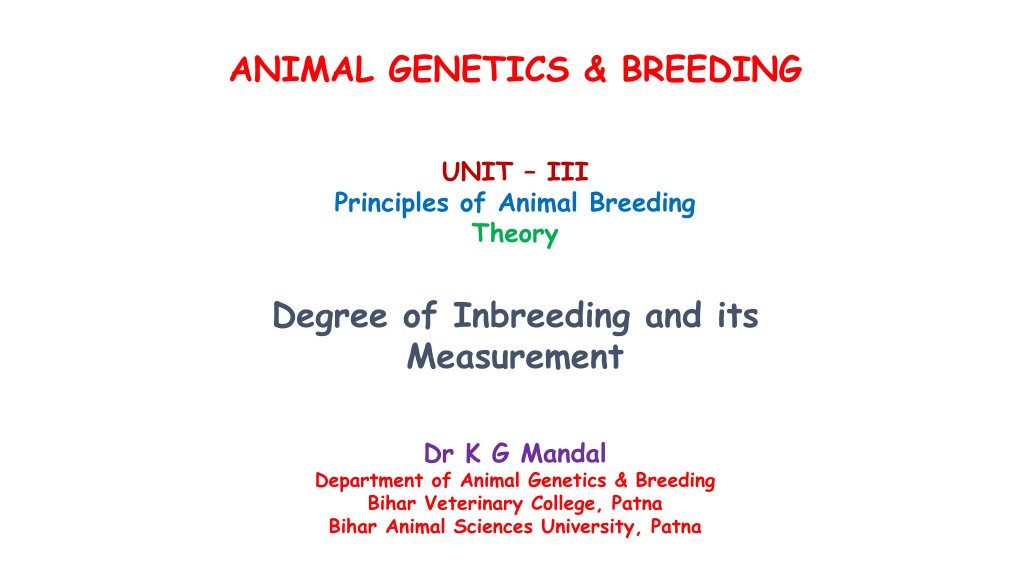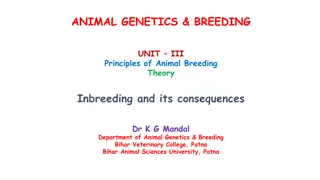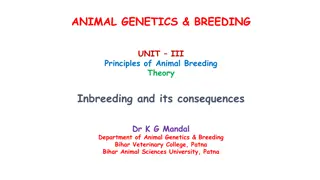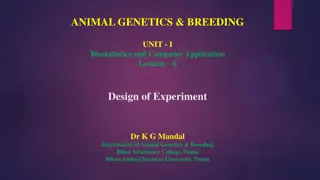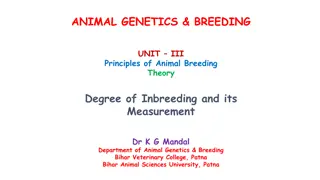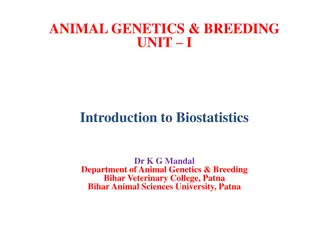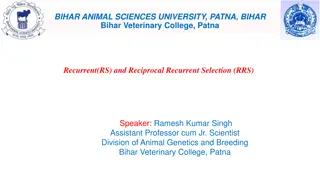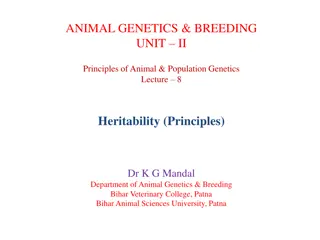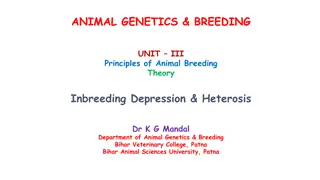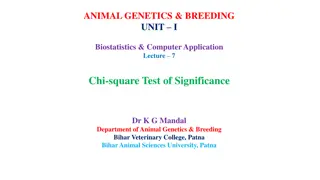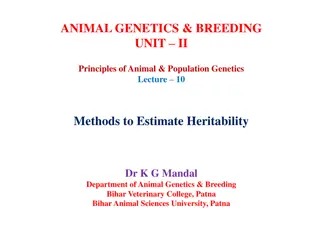Understanding Degree of Inbreeding in Animal Genetics and Breeding
Degree of inbreeding refers to the extent to which an individual carries genes identical by descent. This concept is crucial in animal breeding as it affects genetic diversity and homozygosity in offspring. The coefficient of inbreeding is used to measure the level of inbreeding, with higher values indicating closer relatedness. This article explores the theory behind degree of inbreeding, coefficient of inbreeding, and how it is calculated, emphasizing its importance in maintaining genetic health and diversity in animal populations.
Download Presentation

Please find below an Image/Link to download the presentation.
The content on the website is provided AS IS for your information and personal use only. It may not be sold, licensed, or shared on other websites without obtaining consent from the author. Download presentation by click this link. If you encounter any issues during the download, it is possible that the publisher has removed the file from their server.
E N D
Presentation Transcript
ANIMAL GENETICS & BREEDING UNIT III Principles of Animal Breeding Theory Degree of Inbreeding and its Measurement Dr K G Mandal Department of Animal Genetics & Breeding Bihar Veterinary College, Patna Bihar Animal Sciences University, Patna
Degree of Inbreeding & its Measurement Degree of inbreeding: The extent to which an individual carry the genes identical by descent is the degree of inbreeding or intensity of inbreeding. The degree of inbreeding of an individual depends upon the degree of relationship between the parents of the inbred individual. Prof. Sewall Wright (1921) proposed the method to measure the degree of inbreeding or intensity of inbreeding which is called the coefficient of inbreeding. The coefficient of inbreeding is denoted by F.
Coefficient of Inbreeding: It represents the probable increase of homozygosity in the offspring resulting from the mating of individuals which are more closely related than the average relationship of the population concerned. Definition: Inbreeding coefficient is the probability that the two alleles at a given locus of an individual are identical by descent. Homozygosity of allelic genes at a locus may occur from two sources viz. (i) due to genes alike in state (ii) due to genes identical by descent
Genes alike in state means that two similar genes at a given locus may arise due to: (i) Mutation of one gene or other, or (ii) Two genes may be drawn at random the population and happened to be Genes identical by descent means two allelic genes at a given locus of an individual have been originated due to replication of only one and the same gene from previous generation. from homozygous.
The individual carrying the genes identical by descent at a given locus is called autozygote or identical homozygote and the condition is known as autozygous. Concept to quantify inbreeding coefficient, F : Consider the following pedigree of half-sib mating: A is a common ancestor, B&C are half-sibs and X is an inbred. B (A1A1 or A2A2) X C Probability that X is homozygous for A1A1 = x =1/16 Probability that X is homozygous for A2A2 = x =1/16 Probability that X is either A1A1 or A2A2 = 2x? A (A1A2) ?? =? ? = 0.125
Properties of inbreeding coefficient: 1. Inbreeding coefficient ranges from 0 to 1 in terms of proportion or 0 to 100 %. 2. As the value of F increases, the relative proportion of heterozygous decreases which is represented by (1-F). This (1-F) is known as panmictic index. Thus, panmictic index, P = 1-F.
Methods for calculation of inbreeding coefficient: (i) Path coefficient method developed by Sewall Wright (1921). (ii) Co-ancestry method developed by Malecot (1948). (iii) Variance covariance method derived from path coefficient method.
Principles for estimation of inbreeding coefficient through path coefficient method: Formula was proposed by S. Wright (1921) for computation of inbreeding Coefficient, F, of an inbred individual, X, is as follow: FX= ( ) n1+n2+1+ ( ) n1+n2+1 (FA) = ( ) n1+n2+1 (1+ FA) B n1 X C n2 A
Where, FX = inbreeding coefficient of the individual x . n1 = number of generations from one parent to the common ancestor (A). n2 = number of generations from another parent to the common ancestor (A). FA =Inbreeding coefficient of the common ancestor (A). = Summation over all the paths connecting sire and dam of inbred individual through common ancestor and over all the common ancestors, if the number of common ancestors is more than one.
Steps involved: 1. The pedigree should be presented in the form of arrow diagram. 2. The inbred individual, its parents and common ancestors are to be located. 3. The values of n1 and n2 are to be obtained. 4. If the common ancestor is inbred, its inbreeding coefficient is to be calculated at first.
Rules for tracing paths: 1. The path should connect the two parents of the inbred individual either directly or through common ancestor. 2. The path starting from one parent first goes backward to the common ancestor and then comes forward to the second parent of the inbred individual. 3. No individual in the path is connected more than one time. Thus a path cannot pass through the same individual twice.
Example: Some important points: 1. one(1) is common ancestor for A not for X . Why? 2. As per principle, path starts from one parent (S) of inbred individual (X) going back to the common ancestor (A) and ends at other parent (D) of inbred (X) and no individual will be present twice on the same path. 3. Accordingly, correct path is SAD not SA213AD. In second path A has appeared twice. Hence, SA213AD is not a correct path. S A 2 1 3 X S D A 2 3 1 A D S A D
4. A is a common ancestor for X . 5.The common ancestor (A) of X is inbred. Hence, for calculation of FX ,the inbreeding coefficient of common ancestor (FA ) is to be calculated at first. 6. The value of FA is to be put in the formula for calculation of FX.
Estimation of Inbreeding Coefficient Exercise No. 1. Estimate the inbreeding coefficient of an individual X (FX) from the following pedigree of half- sib mating. S X A D FX= ( )n1+n2+1 (1+FA) = ( )3 = 1/8 = 0.125 or 12.5% CA Path n1 n2 Contribution A S A D 1 1 ( )1+1+1 = ( )3
Estimation of Inbreeding Coefficient Exercise No. 2. Estimate the inbreeding coefficient of an individual X (FX) from the following pedigree of full- sib mating. S A X D B FX= ( )n1+n2+1 (1+FA) = ( )3 + ( )3 = 2(1/8) = 0.25 or 25% CA Path n1 n2 Contribution A S A D 1 1 ( )1+1+1 = ( )3 B S B D 1 1 ( )1+1+1 = ( )3 TOTAL = ( )3 + ( )3
Estimation of Inbreeding Coefficient Exercise No. 3. Estimate the inbreeding coefficient of an individual X (FX) from the following pedigree of sire - daughter mating. S X D FX= ( )n1+n2+1 (1+FA) = ( )2 = 1/4 = 0.25 or 25% CA Path n1 n2 Contribution S S D 0 1 ( )0+1+1 = ( )2
Estimation of Inbreeding Coefficient Exercise No. 4. Estimate the inbreeding coefficient of an individual X (FX) from the following pedigree diagram. S 1 X A 3 D 2 FA= ( )n1+n2+1 (1+F3) = ( )3 = 1/8 Fx= ( )n1+n2+1 (1+FA) =( )3(1+1/8) = 1/8(8+1)/8 = 1/8(9/8) = 9/64 =0.1406 = 14.06% Contribution CA Path n1 n2 1+FA 1+0 ( )1+1+1= ( )3 1 3 2 1 1 3 CA A Path S A D N1 1 N2 1 1 + FA 1+ 1/8 contribution ( )1+1+1 (1+1/8)
Estimation of Inbreeding Coefficient Experiment No. 1. Estimate the inbreeding coefficient of an individual X (FX) from the following pedigree of full- sib mating when the common ancestor A is inbred and its inbreeding coefficient, FA = 1/8. X FX = ? S D A B
Experiment No.2.Calculate the inbreeding coefficient of X from the following pedigree diagram: S B X D C Experiment No.3. Calculate the inbreeding coefficient of X from the following pedigree diagram: 1 S 2 X D 3 4 A 5
Experiment No.4. Calculate the inbreeding coefficient of an inbred individual X from the following pedigree diagram: 1 5 X S 2 6 D 3 7 4 8
Experiment No.5. Calculate the inbreeding coefficient of an inbred individual X from the following pedigree diagram: S B X A D C
Experiment No.6. Calculate the inbreeding coefficient of an inbred individual X from the following pedigree diagram of continuous full-sib matings: S 1 A X D 2 B
Some important values of inbreeding coefficient: The inbreeding coefficient of an individual (X) produced by one generation of selfing is 0.50 or 50.0%. The inbreeding coefficient of an individual (X) produced by continuous 10 generations of selfing 0.999 or 99.90%. The inbreeding coefficient of an individual (X) produced by half-sib mating is 0.125 or 12.50%. The inbreeding coefficient of an individual (X) produced by full-sib mating is 0.25 or 25.0%. The inbreeding coefficient of an individual produced by parent- offspring mating is 0.25 or 25.0%. contd ..
contd.. The inbreeding coefficient of an individual produced by continuous 3 generations of full-sib mating is 0.50 or 50.0%. The inbreeding coefficient of an individual produced by continuous 3 generations of parent-offspring mating is 0.50 or 50.0%. To achieve 50.0% inbreeding coefficient, continuous 6 generations of half-mating required. The inbreeding coefficient of an individual produced by continuous 20 generations of full-sib mating is 0.986 or 98.60%. The inbreeding coefficient of an individual produced by continuous 20 generations of half-sib mating is 0.903 or 90.30%.
Relationship coefficient & its measurement Related individuals in terms of genetics ? Two individuals are said to be related if they have some genes in common due to the presence of common ancestor up to preceding 4-6 generations of their pedigree. Relationship between parent and offspring is the most common form of relation. Offspring receives 50% of its genetic material from each parent. Hence, offspring is related by 50% with each parent. The degree of relationship is expressed as relationship coefficient. Relationship coefficient: It is the probability or percentage of genes which are common between two individuals due to their common ancestry over and above the base population. RXY = Relationship coefficient between X and Y. Properties: (i) Value ranges from 0 to 1. (ii) If X and Y are unrelated, then RXY = 0 (iii) If X and Y are monozygotic twin, then RXY = 1.
Concept coefficient was given by S. Wright (1921) RXY = ( )n1+n2 (1+FA) (?+??)(?+??) Exercise 1. Calculate the relationship coefficient, RXY, between parent and offspring from the following pedigree diagram: X (offspring) Y (Parent) RXY = ( )n1+n2 (1+FA) (?+??)(?+??) = 0, FY = 0 then, RXY = ( )1+0 (1+0) and method to estimate relationship rXY = Cov XY/SDX.SDy , n1 = 1, n2 = 0, FA = 0 FX = = 0.5 (?+?)(?+?)
Exercise 2. Calculate the relationship coefficient, RXY, between half-sibs from the following pedigree diagram: X A Y Exercise 3. Calculate the relationship coefficient, RXY, between full-sibs from the following pedigree diagram: X A Y B
Exercise 2. Calculate the relationship coefficient between X and Y from the following pedigree diagram: X B Y C RXY =? Exercise no. 3. Calculate the relationship coefficient between X and Y from the following pedigree. 1 X 2 5 3 Y 4 RXY = ? A
Some important values of relationship coefficient: The relationship coefficient of an individual with any one of its parent is 0.50 or 50.0%. The relationship coefficient between half-sibs is 0.25 or 25.0%. The relationship coefficient between full-sibs is 0.50 or 50.0%. The relationship coefficient between cousin brother and sister is 0.125 or 12.50%.
